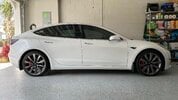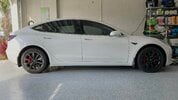After 40,000 miles on the original tires, I decided it was time to figure out if I wanted to spend $365 x 4 + tax + installation (~$1,662) for a set of 20" Michelin Pilot Sport 4S tires, or consider moving to a 19" wheel and cheaper tire. Sure, could have gone with a 20" Fallen Azenis FK510 (~$866 installed) if all I wanted to do was spend less on tires. If I went with the Falken tires, I was concerned my range would decrease and road noise increase. A did a lot of research before changing tire sizes, however, there isn't that much definitive information from Model 3 Performance owners who downsized their wheels from 20" to 19".
I decided to get a set of used 19" Tesla Sport Wheels from a former Tesla owner who sold their car with aftermarket wheels, have those wheels powder coated (just to be different) and install a set of 19" Hankook Ventus S1 EVO tires. Used set of wheels cost $550, powder coating $400, tires $1100 installed, TPMS sensors $78 on Amazon, total of $2,128. So I spent about $466 more than if I had just installed another set of PS4S tires.
Pros of the 19" wheels and tires:
1) I have an extra set of wheels in case I get a flat tire that I can't fix with a tire plug.
2) I can just drop off the wheels, have the tire shop swap out the tires, then I can put them on the car when I want without being concerned about the tire shop causing any damage to my car. I've had this happen more than once so, it's more just something I like to have more control over.
3) I spent more on this set of tires, but the next set of tires will cost about $600 less. Also, if I didn't spend money to have the wheels powder coated, it would have only been about $66 more.
4) Potentially more range. Some estimates show as much as a 3% decrease in range going from 19" to 20" wheels, however, so far I've not seen much in the way of a range increase, it seems more like a range neutral. I see very close to the same Wh/mi on my 80 mile (each way) commute to and from work, on flat land in roughly the same weather. It's gotten a bit cooler so I think I'm using a little more energy but that's more from the cooler temps than any change in the wheels and tires.
5) Very slight improvement in ride quality. It's not much, but I'd say the ride is ever so slightly smoother. Not much difference on rough roads though, which I had expected to feel some improvement but it does not seem to any much better.
6) Maybe a bit more protection against getting a bent wheel, however, I've not run into any issues with the 20" wheels.
7) Maybe another 0.1s faster acceleration, maybe.
8) Road noise is maybe 1db better as measure by my sound meter, but that's comparing a set of worn tires to a set of new tires which probably always causes a slight improvement in road noise.
Cons of the 19" wheels and tires:
1) Spent more than I would have if I had just replaced the OEM tires with another set of 20" PS4S tires.
2) Spent much more than if I had gone with the 20" Falken FK510 tires.
3) IMO, the OEM 19" wheels don't look as good as the OEM 20" wheels. Tires are the same diameter but the larger rims are more to my liking.
4) Overall grip, braking and handling probably not as good as with the Michelin tires but still seems to be pretty good.
After it's all said and done, I'm thinking that maybe if I'd have gone with the Falken FK510 tires, I might have been just as happy, although I would probably have lost a bit of range and performance. Also, I would not have an extra set of wheels in case of a catastrophic flat. I do carry a tire plug kit and a compressor in the trunk though.
I'm sure there is plenty more to discuss but I'll end this post with some pictures.
I decided to get a set of used 19" Tesla Sport Wheels from a former Tesla owner who sold their car with aftermarket wheels, have those wheels powder coated (just to be different) and install a set of 19" Hankook Ventus S1 EVO tires. Used set of wheels cost $550, powder coating $400, tires $1100 installed, TPMS sensors $78 on Amazon, total of $2,128. So I spent about $466 more than if I had just installed another set of PS4S tires.
Pros of the 19" wheels and tires:
1) I have an extra set of wheels in case I get a flat tire that I can't fix with a tire plug.
2) I can just drop off the wheels, have the tire shop swap out the tires, then I can put them on the car when I want without being concerned about the tire shop causing any damage to my car. I've had this happen more than once so, it's more just something I like to have more control over.
3) I spent more on this set of tires, but the next set of tires will cost about $600 less. Also, if I didn't spend money to have the wheels powder coated, it would have only been about $66 more.
4) Potentially more range. Some estimates show as much as a 3% decrease in range going from 19" to 20" wheels, however, so far I've not seen much in the way of a range increase, it seems more like a range neutral. I see very close to the same Wh/mi on my 80 mile (each way) commute to and from work, on flat land in roughly the same weather. It's gotten a bit cooler so I think I'm using a little more energy but that's more from the cooler temps than any change in the wheels and tires.
5) Very slight improvement in ride quality. It's not much, but I'd say the ride is ever so slightly smoother. Not much difference on rough roads though, which I had expected to feel some improvement but it does not seem to any much better.
6) Maybe a bit more protection against getting a bent wheel, however, I've not run into any issues with the 20" wheels.
7) Maybe another 0.1s faster acceleration, maybe.
8) Road noise is maybe 1db better as measure by my sound meter, but that's comparing a set of worn tires to a set of new tires which probably always causes a slight improvement in road noise.
Cons of the 19" wheels and tires:
1) Spent more than I would have if I had just replaced the OEM tires with another set of 20" PS4S tires.
2) Spent much more than if I had gone with the 20" Falken FK510 tires.
3) IMO, the OEM 19" wheels don't look as good as the OEM 20" wheels. Tires are the same diameter but the larger rims are more to my liking.
4) Overall grip, braking and handling probably not as good as with the Michelin tires but still seems to be pretty good.
After it's all said and done, I'm thinking that maybe if I'd have gone with the Falken FK510 tires, I might have been just as happy, although I would probably have lost a bit of range and performance. Also, I would not have an extra set of wheels in case of a catastrophic flat. I do carry a tire plug kit and a compressor in the trunk though.
I'm sure there is plenty more to discuss but I'll end this post with some pictures.
Attachments
Last edited:




